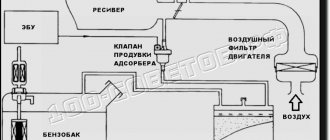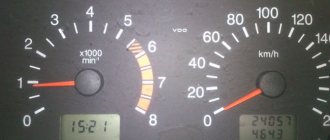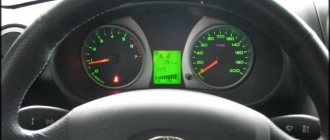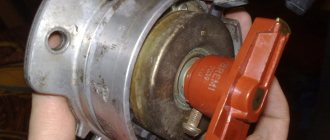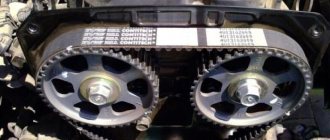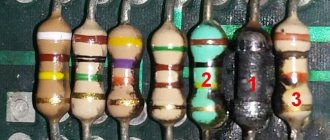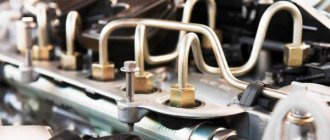03/04/2022 1,797 Dashboard
Author: Ivan Baranov
The tachometer has been mounted on the dashboard next to the speedometer since 1903. This device makes driving easier by showing on the display the number of engine revolutions when you press the gas pedal. Thanks to this, the driver switches gearbox modes in a timely manner.
[Hide]
How does the device work and what does it measure?
The principle of operation of the tachometer is to transform translational action into rotation, the speed of which is measured in revolutions per minute.
The tachometer works according to this principle:
- The driver presses the gas pedal.
- Fuel enters the combustion chamber.
- Here the expansion of existing gases occurs.
- This drives the crankshaft connecting rods.
- The pistons begin to work.
- The number of crankshaft revolutions appears on the display.
The video explains in detail what a tachometer is, how it works and what measurements it displays. Taken from the Avto-blogger channel. ru".
Why do you need a tachometer in a car?
Experienced drivers know that proper use of the tachometer allows you to use all the engine's capabilities to the maximum, while preserving its resource.
If you carefully examine the parameters of some engines, you can find indicators such as maximum power, as well as maximum torque. The basis of these readings has always been, is and will be the number of revolutions of the crankshaft, which is displayed on the tachometer.
To make it clearer for you, we will try to give a basic example. The technical documentation for the engine states: “135 hp.” at 3500 rpm." “420 Nm at 4000 rpm” can mean the same thing. All these numbers mean that the engine will develop its most efficient acceleration or pulling power only at these crankshaft speeds. If the rotation speed is lower or higher than the set value, then the efficiency will be lower, and accordingly, the car will be quieter.
The driver needs these parameters when he changes gears at the gearbox. If you accelerate the engine exactly to these speeds and immediately engage the next gear, you can get the most effective acceleration.
However, you still shouldn’t use this type of engine overclocking too often. The fact is that as the speed increases, the fuel consumption also increases. In addition, too high speeds can lead to accelerated wear of many engine parts and rapid contamination of the oil in the crankcase. Therefore, many experts advise not to “crank” the engine a little to maximum power, thereby creating more economical and efficient fuel consumption.
This is how the tachometer helps to carry out competent gear shifting and preserve engine life for a longer period.
Types of tachometers
The devices differ in their operating principles and are divided into the following types:
- mechanical;
- digital;
- analog.
Mechanical
This type has the largest number of errors. The measurement accuracy is 500 rpm, which is explained by the imperfect mechanism of action. It is based on the creation of an electromagnetic field. The tachometer is directly connected to the crankshaft using a cable through which impulses pass to a moving coil.
Analog
An analog tachometer is an improved type of mechanical device. The difference is the absence of a special cable. The pulses arrive directly at the moving coil (the more there are, the stronger the magnetic induction). The accuracy of crankshaft rpm measurements ranges from 100 to 500 per minute.
Components of the device:
- magnetic coil;
- chip;
- graduated scale;
- arrow.
Digital
The device is connected to the ignition coil, like an analogue one - directly. The difference is that it accepts the frequency of the signals and their interval (instead of pulses). High accuracy of indicators is provided by data from both sides simultaneously - from the crankshaft and idle speed sensors. The obtained indicators are summed up and the average value is calculated and appears on the device screen.
The digital device consists of the following:
- optocoupler (diagnosis of idle air valves);
- ADC 8 bits;
- processor;
- panels;
- liquid temperature sensor.
The measurement accuracy is 100 rpm.
What it is?
What is this in the car? A tachometer is a special measuring device designed to determine the rotation speed of various elements. This indicator is located on the instrument panel next to the speedometer.
The tachometer was invented by American engineer Curtis Widder in 1903, after he invented the cyclometer - a device for reading the mileage of a bicycle. He even had his own slogan: “It’s nice to know how far you’ve traveled.” By the way, a similar device was described in 23 BC. historian Vitruvius. A similar device for measuring distance was invented by the Chinese scientist Zhang Chen two thousand years ago.
What does this necessary device measure? The device allows you to determine the number of scrolls performed per unit of time. The result obtained depends on the intensity of rotation of the rotors, shaft, disk in different machines, mechanisms and units. It is difficult to immediately understand what it does, what it looks like, where it is located and what the device shows.
Popov Andrey Gennadievich
Car mechanic, 19 years of experience
Interesting to know! What does tachometer mean? When translated literally from Greek, τάχος (speed) and μέτρον (measure). Most likely, this is how the modern name was obtained - tachometer, a device for measuring speed.
In addition to the rotation speed sensor, the tachometer can communicate with a special indicator. Therefore, the device consists of two parts connected to each other by electrical communication. Most often, the operating principle of the device is based on measuring the rotation speed of the crankshaft of an internal combustion engine (ICE). The device indicator itself is located on the main instrument control panel, near the driver’s seat, next to the speedometer.
What does the tachometer measure? For a passenger car, the rotation speed is measured in thousands of revolutions per minute. In other vehicles, tachometer values can be in time (hour, min., sec.), distance (km, m, cm), speed (km/h, m/s) and units.
Let's try to understand why a tachometer is needed in a car. It facilitates the process of selecting the required speed (gear). If the arrow on the control panel approaches the red zone, you should shift to the next gear. Normally, the indicators should be in the green area - from 2000 to 3000 rpm, exceeding over 5000 rpm is dangerous for all parts of the car. This power is considered acceptable on racing models.
The tachometer is very helpful in changing gears on time (especially for beginners)
The engine speed tachometer is used for idle adjustment work. What speed does the tachometer show? When starting the engine, the speed should be about 800 per minute. At empty start they should be higher, they can reach 1500 rpm. If there is overheating of the internal combustion engine, a decrease in the speed to nominal is observed. Testing allows you to identify problems if in the summer the car is stationary and does not move, and the rotation reaches 1000. If the idle speed control does not work correctly, excessive fuel consumption is likely. Indicators during testing must be constant, fluctuations within 100 units are permissible.
How to use tachometer information?
It is convenient to use the information obtained from the tachometer when starting the engine in winter. The engine of a cold car produces at least 1000 revolutions when you press the gas pedal. This indicates the inappropriateness of starting the movement. You must wait until the needle in the mechanical device drops to 700 revolutions (or this value appears on the electronic display). When repairing an engine, using the device helps auto mechanics diagnose faults.
The tachometer is capable of showing information about the risk of failure of individual engine parts. This is done using a red arrow or a notch (depending on the type of device). At speeds above 7,000, a dangerous situation occurs for the engine that can lead to breakdowns. The maximum permissible time for maintaining the engine in the “red zone” is 60-120 seconds.
How the device works
Tachometers work according to the following scheme.
- The activated ignition system starts the engine. The air-fuel mixture in the combustion chamber ignites, which sets the connecting rods of the piston group in motion. They rotate the engine crankshaft. Depending on the device model, its sensor is installed on the desired motor unit.
- The sensor reads the crankshaft speed. It then generates pulses and transmits them to the device control unit. There, this signal either activates the needle drive (moves it along the scale) or produces a digital value that is displayed on the corresponding dashboard screen.
The more precise operating principle of the device depends on its modification. There is a wide variety of such devices. They differ from each other not only in appearance, but also in the connection method, as well as in the method of data processing.
Tachometer malfunctions
The most common situations are:
- the arrow twitches while moving;
- The needle jumps at idle speed.
In the first case, there are malfunctions of the cylinder-piston group of the car engine. The driver must have the car diagnosed as soon as possible.
If the needle twitches mainly during acceleration, the following is possible:
- lack of fuel;
- stretched timing belt;
- The camshaft drive chain is loose.
If the device does not operate properly at idle, the reason is as follows:
- low fuel quality;
- interruptions in sparking (failure of wires supplying voltage);
- mechanical damage;
- fatigue of device components.
Sometimes the following situations arise:
- The screen of the digital device does not light up. LEDs need to be replaced.
- The tachometer constantly gives incorrect measurements. The problem may be with the internal combustion sensor.
How to use a tachometer correctly?
Not everyone knows what the numbers on the tachometer mean. They are especially important for a driver who cares about the engine of his car in winter. The data shows the readiness of the engine for full operation. This is important because some modern and Soviet cars do not tolerate starting well without warming up. As a rule, drivers wait until the antifreeze temperature is optimal and then start driving.
With a tachometer, it is much easier to control the optimal moment to start moving. You can start driving when the needle on the device reaches 750-800 rpm at idle start (in some brands of cars this figure may be higher). At this moment, the engine is already warmed up, and minimal fuel is consumed for this.
For optimal overclocking, you must adhere to the following algorithm:
- We engage 1st gear, and when the revolutions approach the 3500-3800 mark, we switch to 2nd gear.
- Then the speed is reduced to 2300-2500.
- When the revolutions rise to 3500, switch to 3rd gear.
- The speed drops again to 2500.
- Again we pick up the speed to 3500, switch to 4th gear. And so on, until the maximum gear is reached (5 or 6).
Popov Andrey Gennadievich
Car mechanic, 19 years of experience
To accelerate the car very quickly, you need to reach a high rpm (5000-5500) in 3rd or 4th gear. But here fuel consumption will sharply increase and engine wear will increase. Of course, you can accelerate at idle speed, but the wear on the engine will be very strong.
If you carefully monitor the speed and change gears in time, then all the engine power will be used, but do not forget that at maximum acceleration, fuel consumption will increase . Therefore, in order to significantly save on fuel, you need to keep the speed below the maximum power. But if you frequently and greatly reduce the speed, this can lead not only to an increase in fuel consumption, but also to a decrease in the service life of the internal combustion engine.
Use the device's readings on the go. Based on the displayed data, the possibility of changing to the next gear and the ability to safely reduce speed on a certain section of the route are assessed. For maximum acceleration, you need to collect the greatest number of rotations. The car will accelerate quickly, but it will consume a lot of fuel.
Attention! The device is of informative value for repairmen. Without it, it is difficult to conduct diagnostic tests.
Is it possible to determine driving speed using a tachometer?
Sometimes situations arise when it is necessary to determine the speed using a tachometer (the speedometer has failed). If your device allows you to display data in distance units (meters, kilometers), you need to select this function. The determination of the speed of movement will be visible on the board.
In the case where the device only shows revolutions per minute, you can manually carry out the calculations. To do this, you need to measure the time it takes to cover the distance and calculate the speed.
How to make eyelashes for headlights with your own hands: manufacturing options
I’ll give you a few more general recommendations, and also touch on the topic of at what speed you should switch if the driver prefers to navigate by the tachometer. This is true for beginners who simply do not yet know how to rely on the sound of the engine.
- Always try to keep your foot on the designated resting area. Do not hold it directly over the pedal;
- Adjust the position of the chair relative to the box to suit you. When shifting, you should not reach for the lever;
- When performing actions with the box, be sure to move your left hand to the center of the steering wheel, to its top point. This will allow, if necessary, to perform an emergency maneuver with only one hand;
- Initially, it is recommended to switch using the tachometer;
- If you have a diesel engine, then the transition from gear to gear is carried out at 1500-2000 rpm;
- For gasoline engines, the current range on the tachometer is 2000-2500 rpm.
These are really important recommendations that should be strictly followed.
Everything comes with experience and practice. But competent work with a manual transmission allows you to significantly save fuel, preserve the integrity of the transmission components, engine and pedal assembly, and also use every horsepower to the maximum.
How to connect a tachometer yourself?
Step-by-step instructions for connecting a device for a carburetor car look like this:
- The black wire is pulled to the ground of the car.
- The red cord must be connected to the terminal in the ignition switch.
- The third wire is connected to the ignition coil (via a distributor or voltage switch).
- The backlight is connected to the dimensions.
On diesel cars, the tachometer is installed differently:
- The generator protection is disconnected.
- The connection occurs to a specially routed cord on the side of the terminal with the letter W.
- The wire coming from the winding is disconnected and insulated.
What is a tachometer
If you pay attention to the dashboard, you can see a dial gauge that has several divisions “1, 2, 3...” and so on until “7-8”. At the end of this division there is an area marked in red. All this displays the engine speed per minute, and the last, red part indicates that this mode is dangerous for the engine.
To decipher the numbers on the device, you need to see what is written in the middle . In most cases, x1000 is indicated there. This means that the numbers on the division need to be multiplied by 1000 and then we will get the number of revolutions that the crankshaft makes per minute. This was done for the purpose of not painting a large number of zeros on the dial.
Initially, tachometers were not used in cars, since manufacturers considered it necessary to control only the speed of the car. Therefore, most cars were equipped with only one main device - a speedometer. Over time, most of the reasons why the use of a tachometer became necessary have appeared. They also determined its practical application.
Is it necessary to purchase a tachometer and how to choose the right device?
The requirement to have a device for determining the angular velocity of the motor shaft is not regulated in regulations. The driver makes the decision independently, based on personal needs and financial capabilities. If you replace an old tachometer, you must select a new one taking into account the technical characteristics of the car.
If the car owner has decided to install the device, you should pay attention to the following manufacturers:
- Helios (Russia);
- Multitronics (Russia):
- CEM (China);
- KET Gauge (China - Taiwan).
Tachometers are available digital and analogue
Digital tachometers are made in the form of an electronic display, which displays all the necessary information (calculations of shaft and engine revolutions).
The analog tachometer is one of the first and is used on most cars, and the values are shown using an arrow. The operation of an analog tachometer is carried out according to the electronic principle - a signal from the shaft is transmitted to a microcircuit, which sets the movement of the needle along the scale.
The method of installing a car tachometer can be standard or remote. Remote tachometers are usually used in sports cars, where precise adjustment of engine speed is necessary.
Photo gallery
The photo shows the location of the analog device on the dashboard
Digital tachometer
Device connection diagram
What is a tachometer sensor
A tachometer sensor is any device designed to record important signals necessary for the operation of the measuring instrument. Among such sensors are the idle speed sensor and the crankshaft sensor.
The crankshaft sensor records the angular position of the crankshaft at certain points in time. The sensor can be installed at the rear or front of the engine, most often near the flywheel. Such a device allows you to accurately measure the speed and transmit the corresponding signal to the car’s dashboard.
The idle speed sensor is installed in the vehicle's intake system. He also takes part in determining the crankshaft speed based on the amount of fuel supplied. The idle speed sensor is installed on the engine carburetor and, through wires, sends the impulse necessary for the tachometer to operate.
Another option for connecting the device involves connecting it to an electronic engine control unit. Finding it is not difficult, since not a single wire will stick out of it. Thus, the sensor works in close cooperation with the ECU and transmits the corresponding readings to the measuring instruments.
That's probably all you need to know about a car's tachometer. As you can see, with due attention this is a fairly simple and important device that should not be neglected at all.
Where is the tachometer used?
Although a tachometer is usually called a device located in a car, its range of uses is very wide. It is widely used to read the speed of rotation of moving parts in mechanisms, machines, units (disks, various shafts, etc.).
In addition, the device is used in calculating the wear of mechanisms, equipment elements, raw materials in the operation of conveyors, liquid and gaseous media in pipes. When running in machines and machines, to measure the operating time of equipment.
The test result can be translated into measurements in meters and minutes that only the driver can understand.
The design and principle of operation of the tachometer
The structure of tachometers of different types is discussed in the table “How different types of tachometers are constructed.” If the table is not completely visible, then move it to the left.
| View | Design |
| Mechanical | The main part is a cable, using which the device is connected to the engine crankshaft. The other side of the circuit component is located behind the instrument scale. During the rotation process, the central pulley wraps around inside the casing, and the torque is transmitted to the gears, which provoke the movement of the arrow. |
| Analog | There are no visual differences between mechanical and analog devices. Externally, these devices look the same, but the device of the second one is more complex and this allows for increased accuracy. The device itself consists of 4 components: sensor, magnetic coil, pointer, scale. |
| Digital | Electronic – accurate when compared with other options. It consists of an optocoupler, processor, sensor and digital display. |
Interesting! Which sensor is responsible for the tachometer? These are the crankshaft and idle speed sensors, as well as the electronic control unit.
The functionality of the devices is ensured according to the following scheme:
- After activation of the ignition system, the engine starts. The fuel mixture ignites in the chamber, which provokes the movement of the connecting rod.
- The chain component starts the rotation of the engine crankshaft.
- The tachometer sensor is in the desired position, on one of the circuit sections.
- The mechanism independently reads the number of rotations, creates impulses and transmits them to the control panel of the device. There this signal moves the pointer drive.
- The arrow moves along the scale with the desired resistance and displays a numerical value.
How a tachometer works
In simple words: the crankshaft sensor reads its revolutions and transmits this data to the control unit, which sends a signal to the tachometer.
The accuracy of the devices varies and depends on the type of sensors used. Visually, they are all similar, the main differences are in the way they connect and process data.
Video: How the tachometer works
In this video, the expert talks about the principle of operation of the tachometer, why in some cases it can work without voltage in the on-board network, and in what cases it cannot do this.
Operating principle of electric tachometers
Electric tachometers use electrical signals or individual pulses to measure. Electrical signals proportional to the crankshaft speed in a gasoline engine are generated by the ignition system and an electric generator, and in a gasoline engine only by the generator. The necessary signal can also be received from the electronic engine control unit.
The simplest way to operate is a tachometer connected to an electric generator. The generator is driven from the crankshaft via a V-belt drive, so the generator rotor speed is always proportional to engine speed. And the magnitude of the EMF generated on the winding depends on the rotation speed of the generator rotor, which is used to connect an electric machine tachometer. In essence, the device is a voltmeter that measures the voltage on the generator and converts it into crankshaft speed readings. The tachometer is connected to the generator through a special connector, which requires adjustment of the device to the specific generator.
The operation of the electronic tachometer connected to the ignition system is a little more complex. The ignition system generates current pulses necessary to produce a spark in the spark plugs. In this case, the frequency of sparking is directly related to the frequency of rotation of the crankshaft - otherwise the fuel-air mixture in the cylinders would not be ignited in time. The frequency of sparking depends on the number of engine cylinders and the order of their operation. In four-cylinder engines, the ignition system generates two sparks per revolution of the crankshaft - one spark for every 180°. It is this circumstance that is used to operate electronic tachometers - the measuring unit measures the sparking frequency and converts it into engine speed readings. An electronic tachometer is connected to the primary (low-voltage) circuit of the ignition system and measures the number of pulses per unit of time, which is why this type of device is often called pulse.
Simple tachometers for motorcycles and other devices with one- or two-cylinder two-stroke internal combustion engines operate on the same principle, but such devices are connected to the high-voltage part of the ignition system. Connection - using a wire wrapped around a high-voltage (spark) wire. In this case, the number of pulses on the spark plug is directly measured and this parameter is converted into readings of the engine speed.
A tachometer is a simple and reliable device; this device can operate flawlessly throughout the entire life of the vehicle. But in the event of a breakdown, the device should be replaced as soon as possible - only in this case will the engine operate and the vehicle operate in optimal mode.
Tachometer device
The tachometer consists of several main components: a measuring unit or signal converter, an indication unit and auxiliary components.
The measuring unit of mechanical and electromechanical tachometers is most often magnetic, similar to a conventional speedometer (in essence, the speedometer is a tachometer that measures the speed of rotation of the secondary shaft of the gearbox or wheel). This speedometer is connected to the engine with a flexible shaft.
The measuring unit in electrical devices can be built using analog circuitry using transistors or using digital circuitry based on specialized microcircuits. This unit receives a signal from the sensor, ECU, generator or ignition system, processes it in accordance with the preliminary settings, and the converted signal is sent to the display unit.
The display block can be of several types:
- Pointer indicator (with pointer drive by milliammeter);
- Digital indicator based on liquid crystal or LED display;
- Indicators with a linear LED scale - the role of an arrow is played by a line of LEDs of different colors.
Cars usually use dial indicators, which are easier to read and allow you to immediately determine in which mode the engine is operating. Digital and LED indicators are most often installed during tuning; they are also used in simple tachometers for motorcycles, diesel generators, etc.
The tachometer scale is divided into several zones, marked in different colors:
- Low speed zone - in this speed range the engine is unstable, the zone may be marked in red;
- Optimal speed zone (?green zone?) - in this range the engine develops the greatest power and torque, usually the zone is marked in green;
- High speed zone - this speed range is conditionally dangerous for the engine; usually this zone is marked in yellow or a line above the red zone;
- High speed zone (?red zone?) - this speed range is dangerous, the engine is overloaded and operates with low efficiency, this zone is marked in red.
Tachometer for diesel
The operating principle of a diesel engine is fundamentally different from an internal combustion engine, therefore the tachometer design has undergone significant changes. In particular, to take into account the crankshaft revolutions, the rotation value of the generator is taken. The meter receives a pulsed indicator of alternating current, the high frequency of which indicates an increased amount of rotation speed. When you independently connect the tachometer to a diesel engine, the terminal marked “W” on the car generator will be used. After this, it is necessary to calibrate the device using a diagnostic stand. In addition to its main functions: monitoring the maximum and operating indicators of crankshaft revolutions, the use of a tachometer will allow you to timely diagnose possible problems in the operation of the mechanism.
Why do you need a tachometer?
The presence of this device does not in any way affect the operation of the vehicle or its individual systems. Rather, it is a device that allows the driver to control the operation of the engine. In older cars, engine speed could be determined by sound.
The vast majority of modern cars have excellent sound insulation, thanks to which even the sound of the engine is barely audible. Since constant operation of the engine at high speeds is fraught with failure of the unit, this parameter must be monitored. One of the situations in which the device will be useful is to determine when to engage an upshift or downshift when accelerating a car.
What malfunctions can there be
A mechanical type tachometer may be faulty if its structural elements are damaged. For example, if deformations occur, the cable breaks, or play appears. As for electronic devices, there may be several causes of failure. Let's look at them in more detail:
Electrical wiring is damaged, incl. signal wire.
The contacts have oxidized, or they have loose contact.
The elements of the measuring unit are damaged (burnout of microcircuits, swelling of resistors).
If the device is connected to a generator, then the generator itself is not working. A problem is indicated by a low battery indicator. It happens that the needle starts jumping without any reason. The driver should carefully inspect the wiring, engine components and the device itself.
If the device indicators do not change even when the accelerator pedal is pressed firmly, then it is necessary to check the integrity of the wiring. The tester will help the driver with this.
Which tachometer to choose
Car tachometers use magnetic induction during the measurement process, which controls the pointer needle on the dial. They require periodic calibration and repair. The error when measuring using an analog device is 10% (500-600 rpm). This type of device is more common; when driving a car, it is its readings that are more easily perceived by the eye.
A digital tachometer displays measurement data on an electronic display. There are digital tachometers that completely imitate the appearance of analog ones with arrows, but more often there are simple ones - with a digital panel. The error in measurements using them is 3-4%, which is much lower than that of analog equipment.
Indispensable when determining car economizer thresholds, or when adjusting interaction with electronic units. In short, accurate measurements cannot be made without this device.
By location, you can distinguish between a standard and remote tachometer. Standard models are so called because they are usually included in the set of vehicle devices. If the tachometer is pointer, then it is located next to the speedometer, and a digital tachometer is often attached to other devices.
It makes sense to purchase a remote one if the car is not equipped with a tachometer. Typically used in motorsports where precise control of engine speed is required.
Tachometer for a diesel engine, operating principle, types of video
A fan with a heating function for a car for 600 rubles. Car cigarette lighter fan with heating function
Unlike other devices installed on cars, the tachometer for a diesel engine is connected through a generator. The device itself is designed to determine at what frequency the crankshaft rotates. In other words, the tachometer shows the number of revolutions over a certain period of time.
You can see the tachometer readings directly while driving; it is located near the speedometer on the instrument panel. Various types of sensors are used to take readings; depending on this, the measurement method can be non-contact or contact. Tachometers are used not only in cars, but also in other devices where control over rotation speed is required.
However, it is in cars that this device has found its widest application. Not a single modern car can do without this device, which allows you to control the operation of the engine and change gears in a timely manner. All this helps to increase service life, contributes to fuel economy, and ensures traffic safety.
There are many varieties of these devices that are used in certain cases.
The very first tachometer was a centrifugal one, where the energy coming from the mechanism is transmitted through an axle. The impact on the arrow in each case is carried out differently, depending on the design of the device.
Tachometer for a two-stroke engine - applications and selection
An electronic tachometer for a two-stroke engine should be considered separately.
One of the varieties of such a device is a waterproof version, used in motorcycles, scooters, snowmobiles and other vehicles with two-stroke engines.
In practice, this is the same as a tachometer for a single-cylinder engine, which determines its service life, as well as the frequency of maintenance, such as valve adjustment, oil change, spark plugs, etc.
Installing such a device on the mechanism is very simple. There is no need for a separate battery thanks to the built-in rechargeable battery. The connection is made directly to the wire of one of the spark plugs. The resolution of such a device is 0.1 hours, it can count up to a maximum of 10 thousand hours, and then reset.
Tachometer dials vary in size.
When a certain number of revolutions is reached, a special flash lamp is activated, after which the gear shifts into the next gear. Such large tachometers take up a lot of space and partially block the view.
Tachometer scale and its additional features
The design of each tachometer in a car provides for working with a specific number of cylinders. The bulk of these devices work with four-cylinder engines.
In some models it is possible to switch to the required number of cylinders.
Depending on the engine speed, the scale graduation has different meanings and can reach from 8 to 11 thousand revolutions per minute.
Certain types of tachometers equipped with a flash can remember the highest number of engine revolutions. The tachometer may additionally include other devices that display engine operation.
Such devices are called multidevices.

